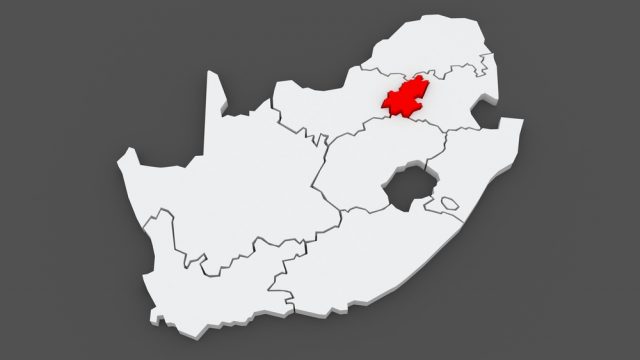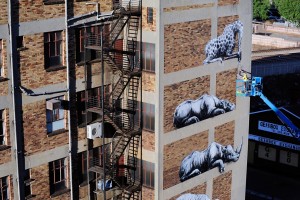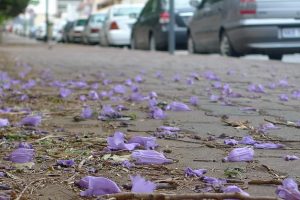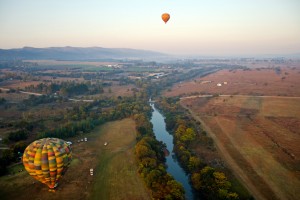Gauteng, South Africa’s smallest but mightiest province, is often the first place that visitors to the country arrive. Home to OR Tambo International Airport, one of Africa’s largest transit hubs, millions of travelers pass through Gauteng every year on their way to … Cape Town, Kruger Park, or the Garden Route.
The fact that Gauteng (pronounced “how-teng”) is not as popular as other more “glamorous” tourist destinations has given the province something of an inferiority complex, but even though it’s not as overtly touristic as other parts of South Africa, it does indeed have a lot to offer the motivated traveler.
Gauteng – which means “place of gold” in the Sotho language – started out as a small gold mining town in the late 1800s, and since has grown to a thriving province of more than 12 million people from all over Africa, which gives it a unique energy and outlook. It’s home to Johannesburg, South Africa’s commercial and financial hub, Pretoria, the country’s capital, and numerous cultural, recreational and culinary attractions. And even though it’s primarily urban, there are numerous less-dense areas where nature lovers and animal-lovers can get their fix as well.
Gauteng’s high altitude translates into a mild climate, which makes it perfect to visit almost any time of year. And the rapidly-declining crime rate is boosting tourism as word gets out that Gauteng is a safe place to be out and about.
Johannesburg
Joburg, as the natives call it, is South Africa’s business hub. Most commerce used to be centered in the downtown area, but much of it has now moved to rich but generic northern suburbs such as Rosebank and Sandton, and along with it, the most popular hotels and restaurants. Most tourists venture into downtown only to take a bus tour or explore trendy emerging neighborhoods such as Maboneng or Braamfontein, but they stay in hotels in the safer northern areas and shop and dine there.
Other neighborhoods worth exploring include Melville, a bohemian area home to artists and actors; leafy Parkhurst, where you can find cafés, boutiques and restaurants spilling out onto 4th Avenue; Cyrildene, Joburg’s very own Chinatown; and Parktown, where the city’s first mining magnates built their imposing mansions (visit the beautiful gardens of the century-old Brenthurst, owned by the Oppenheimers, the city’s aristocracy, by appointment).
There’s no better place in South Africa than Joburg for engaging with South Africa’s dark past. The excellent Apartheid Museum, which is heart-wrenchingly poignant with its admirably inclusive multimedia exhibitions of hundreds of years of colonialism and racial segregation, is worth spending at least several hours in. On the edge of the CBD is Constitution Hill (www.constitutionhill.org.za), the site of Apartheid-era prisons that once incarcerated Nelson Mandela and Gandhi, amongst other famous political dissidents.
One of the city’s most popular attractions is Soweto, South Africa’s infamous township. Various tour operators offer half- or full-day tours that take in sights such as the church that provided a safe haven for freedom fighters (chat to the caretaker and he’ll show you the bullet holes in stained glass windows from battles with the police), as well as Mandela House and the Hector Pieterson Museum, which documents the student uprisings of 1976 through oral history.
For a taste of Joburg’s gold-mining past, visit Gold Reef City, an amusement park with a gold rush town theme, complete with a main street designed to look like the city at the turn of the century. Go on rides such as “The Miner’s Revenge” or take the “Story of Gold” tour, where you’ll descend several stories into an old underground gold mine and try your luck at gold panning back on the surface.
For such a big city, Joburg is surprisingly green: it is one of the world’s largest man-made urban forests, with over 10 million trees. Escape the hectic pace of the city in one of its green spaces: there’s the beautiful Botanical Gardens with thousands of rose bushes and indigenous trees next to Emmarentia Dam; Zoo Lake, where you can ride a boat on the lake or catch Carols by Candlelight in December; and Melville Koppies Nature Reserve, a wild piece of nature only a few miles from the heart of the city where you can participate in guided hikes.
Other popular attractions and pastimes in Joburg include the Johannesburg Art Gallery, the Johannesburg Zoo, which is home to lion cubs,
Pretoria
Johannesburg may have an inferiority complex in relation to Cape Town, but Pretoria has one in relation to Joburg. But Pretoria has its own beauties and charms, such as the purple-hued streets when the jacaranda trees come into full bloom, the blue-lined stadium and pubs when the Blue Bulls (the national rugby team) is playing, and the green drinks of cane and cream soda that the students go crazy for in Hatfield.
On the ‘must see’ list of Pretoria’s sights is the Voortrekker Monument which was built to commemorate the Voortrekker Pioneers and their journey from the Cape colony into the interior of the country. While there you can visit Erfenissentrum, the centre dedicated to Afrikaners and how their life used to be.
Then you’ll also have to take a trip to the Union Buildings, the official seat of the South African Government (SA’s version of the White House). Take another step back into South Africa’s history at Church Square in the CBD where you will see the city’s first church, built in 1855.
Get a sense of some of South Africa’s cultural history at the National Cultural History Museum or the Art Museum. Another good museum to visit is the National Museum of Natural History.
A great activity if you have kids is to spend a day at the Pretoria Zoo, they have a wide array of animals and a really amazing aquarium. Another fun place to take the kids is Irene Dairy Farm just outside of Pretoria, check out the animals, take a stroll along the grounds and enjoy some delicious freshly prepared food at their restaurant. While in the area, you can visit Jan Smuts House, an ex-president of South Africa. If you’re there on the first Saturday of the month then you can catch the Irene Market on the same grounds.
Magaliesberg/Hartbeesport
Thirty miles northwest of the city is an idyllic region filled with quaint country houses, luxury hotels, rustic lodges, stylish stores, funky arts and craft studios, working farms, horse and mountain bike trails and more. It’s a popular spot for Joburgers and Pretorians to go for a weekend getaway, and it’s worth visiting even if you’re in South Africa just for a short time. Here are some of the most popular places and pastimes:
Cradle of Humankind: This is a UNESCO World Heritage Site where some of the 40% of the world’s hominid fossils were excavated, included some of the oldest. The 53,000-hectare area is also home to a diverse array of birds, animals and plants. Visitors can walk through the damp, dark Sterkfontein Caves to see where many of the fossils were found, and visit the Maropeng Centre for replicas of the fossils.
Hot air ballooning: Float over the Magalies river valley and spot springbok, feel the breeze, and revel in the total silence that engulfs you as you survey the beautiful landscape.
Carnivore Restaurant, Muldersdrift: On your way to or from Magaliesburg, stop by this fun African-themed restaurant, where meat in all forms is the main attraction. Zebra, impala, crocodile, ostrich, and move “conventional” domestic meats are skewered on Maasai swords and charcoal-grilled over a circular fire located in the centre of restaurant.
Magaliesberg Canopy Tour: This 2.5 hour zip-line/canopy tour allows visitors to enjoy Ysterhout Kloof in the Magaliesberg range from a different angle. Its 11 platforms, set high on rock faces, are linked by 10 aerial slides that are up to 140m long in places and over 30m high above the tree canopy. Guides relate not only ensure safety, but also relate facts and stories about the mountains’ history, plants and animals.
Enjoy a cable-car ride taking you to the top of the Magalies Mountain, giving you a breathtaking view of the Hartbeespoort Dam, or a ferry-boat ride on whole family with a variety of animals.
Cullinan Diamond Mine
Gauteng was originally founded in the gold-mining days of the late 19th century, and diamonds were discovered soon after. Those interested in learning a bit more about this aspect of Gauteng’s history should consider taking a tour of the Cullinan Diamond Mine in Cullinan. Visitors get to tour the diamond display room, which houses of replicas of famous diamonds (including the 3106-carat Cullinan Diamond), a life-size mock-up of an underground tunnel, the shafts where the kimberlite rock is raised from 500m underground, the winding engine room, and the lookout point for the “Big Hole.”
Nature and Wildlife Reserves
- Johannesburg Lion Park: situated about 45 minutes away from Johannesburg by car, is a must see for all age groups. A quick round trip would take about 2 hours, but one can enjoy just as many hours inside the park if you have the time.
- Roodeplaat Dam Nature Reserve
- Kloofendal Nature Reserve
- De Onderstepoort
Getting around
Gauteng is not easy to navigate if you don’t have your own car — its sprawling geography means that it’s not possible to get around on public transit unless you want to confine yourself to a small area. If you’re going to be traveling around a lot and feel comfortable driving in an unfamiliar place, it’s best to hire a car at the airport or from your hotel. Most major companies have offices in Gauteng, including Avis, Budget, Europcar, and Sixt (for cheaper rates). International visitors must have a valid license and credit card, and miles are generally unlimited if you don’t live in South Africa.
As far as public transport systems, Johannesburg now has a safe and efficient train service, the Gautrain (pronounced “how-train”), which travels between the airport, Sandton, downtown Johannesburg, and Pretoria.
The Rea Vaya bus network operates in Johannesburg on routes between Braamfontein, the Central Business District and Soweto (with plans to add more routes).
If you opt for taxis, it’s best to take metered cabs from reputable companies (ask your hotel for options) rather than hail one off the street ask you hotel concierge or restaurant hostess for a recommendation.
Another option in Johannesburg is Uber, the online car service, which requires you to download an app to your smartphone in order to request a taxi. Uber is cheaper than conventional taxi services, and is cash-free — all charges are billed directly to your credit credit card.
Accommodation
Gauteng has perhaps the widest array of accommodation of any province in the country, ranging from private apartment rentals, to homey B&Bs, to serious business hotels, to swank five-star resorts. Go to AFKTravel.com’s hotels page to search for the perfect hotel for your stay.
Dining
There are literally thousands of restaurants to choose from, of all price ranges and ethnicities. Go to AFKTravel.com’s restaurants page to search for the dining style, food type and price range you prefer in Gauteng.
Practical Considerations
Weather: Owing to Gauteng’s high altitude, the weather is quite temperate and mild. Summers are hot and dry by day, with brief afternoon thunderstorms and rainfall. Summer nights are generally cool but not cold. Winters are crisp and also dry, with warm days and chilly nights. Frost sometimes occurs in the southern areas of Gauteng.
Tipping: A service charge is not usually included in restaurants; a tip of 10% of the bill is standard, with exceptional service qualifying for 15%. Tipping of porters, taxi drivers and petrol attendants is common, but not obligatory. A similar amount of 10% or so is appropriate.
Safety: Aside from seedy parts of Johannesburg, crime is not a big concern for the average tourist and security tends to be very tight in hotels, shopping centres and airports. However, its always important to be be vigilant and not flash money, jewelry or cameras when out and about. Don’t leave valuables lying in plain view in your car, and be careful when entering gated complexes (either on foot or in a car) to make sure no one follows you in. When driving, make sure you have a GPS device in the car so you don’t get lost, and the number of roadside service in case you break down. However if you do have an emergency, the following numbers should come in handy.
- Police: 10111
- Ambulance: 10177
- Fire: 011 375 5911
- For car breakdowns, call the Automobile Association: 0861 000 234
Health: Gauteng is a malaria-free zone, and there are virtually no other infectious diseases you can get besides the usual suspects: colds, flu, and unfortunately, HIV. Take precautions such as washing hands often, avoiding sick people, and using condoms. More common afflictions include sunburn and hay fever, so wear sunscreen even when it’s overcast, and bring allergy meds if you have sensitivity to pollen.
Healthcare is top-notch in Gauteng, with over 30 public and 40 private hospitals in the province. Hospitals with 24-hour emergency rooms include:
- Johannesburg Hospital : Tel. 011 488 4911 in Parktown
- J. G. Strijdom : Tel. 011 489 1011 in Auckland Park
To avoid a long wait, you’d be better off at a private hospital like MediClinic Morningside (011 282 5000), off Rivonia Road in Sandton, or Milpark Hospital (011 – 480- 5600), off Guild Street in Parktown.
Further information






